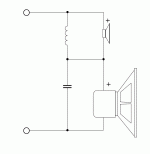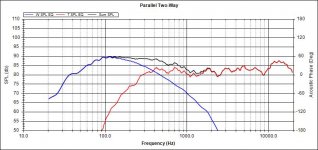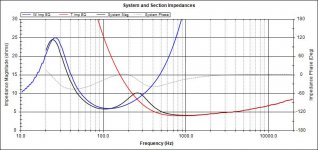Oh wow! I'm so glad my project sparked real discussion.
I'm sorry for going MIA till now; my grandmother broke her back last Friday, so I've been helping the family handle that and haven't been able to check back.
Thoughts in no particular order:
I considered going active with a miniDSP, but I am a grad student and I can't justify to my wife the price of a miniDSP and 2 separate amps. That said, I would the appreciate the practice and experience making my own old-school crossovers. Like learning long division by hand before using a calculator.
@Planet:10
@waxx
For that matter, I'm guessing you cannot model these in WinPCD? Was that software you used XSim? I have not tried that; mainly because I don't know enough of the science to look at the frequency response and say, "oh, it needs a coil here to rolloff at ##hz and a cap parallel something something". The hyper-simplified layout of WinPCD helps me understand what each component in the system is accomplishing. That said, I just did a quick search for parallel vs series crossovers and have quickly learned it might be over my head I apologize if you don't have the time to teach me the alphabet. Are there sources your are aware of that might helpful to an educated, but in the completely wrong field, person?
I apologize if you don't have the time to teach me the alphabet. Are there sources your are aware of that might helpful to an educated, but in the completely wrong field, person?
Regardless, thanks so much everyone
I'm sorry for going MIA till now; my grandmother broke her back last Friday, so I've been helping the family handle that and haven't been able to check back.
Thoughts in no particular order:
I considered going active with a miniDSP, but I am a grad student and I can't justify to my wife the price of a miniDSP and 2 separate amps. That said, I would the appreciate the practice and experience making my own old-school crossovers. Like learning long division by hand before using a calculator.
@Planet:10
Might I ask why the .707 multiplicity? Is that to take into account the gradual rolloff from the crossover? That is, so that the woofer is a few db down at the baffle step "point"?10” gives a nominal Bs(-3) ~ 456 so XO between that and 0.707 times ~320 Hz
@waxx
@Planet10As nerdy as i am, i messed around with this data for maybe an hour and came to this. It's a second order serial crossover without zorbel or bsc as it looks best without, but with a notch filter to tame the treble. 1st order and parallel crossovers did not work well with this setup for one or the other reason. You find the project files included.
I only have experience designing and modeling parallel crossovers and don't have the electrical background to know the difference with a series. What is the benefit of doing a series crossover?I like series XOs, one of the times i did a passive i couldn’t get anywhere w parallel, th eseries just popped.
For that matter, I'm guessing you cannot model these in WinPCD? Was that software you used XSim? I have not tried that; mainly because I don't know enough of the science to look at the frequency response and say, "oh, it needs a coil here to rolloff at ##hz and a cap parallel something something". The hyper-simplified layout of WinPCD helps me understand what each component in the system is accomplishing. That said, I just did a quick search for parallel vs series crossovers and have quickly learned it might be over my head
Regardless, thanks so much everyone
I considered going active with a miniDSP, but I am a grad student and I can't justify to my wife the price of a miniDSP and 2 separate amps.
Amps, particularily Class D amps ideal for bass are cheap these days (ie got a 4x100w into 4Ω assembled board for $50 and then a case on hand and Daniel twealed a PC switcher and i had an amp to drive my 4 x 10” SDX10 for <$150.
Or even the amps out of a $20-50 charity shop or boot sale find. I have a 50w Technics that cost me $5 (bashed speaker terminals, missing knobs, works fine).
If one is careful with the design of the speaker, one can get away with a 1st order PLLXO, which costs nect to nothing, particularily if built into a cable — RCA connectors cost more than the parts.
Might I ask why the .707 multiplicity? Is that to take into account the gradual rolloff from the crossover? That is, so that the woofer is a few db down at the baffle step "point"?
Mostly. And experience. Each speaker, room, wil be different, but i usually start at the lower end of the range.
I only have experience designing and modeling parallel crossovers and don't have the electrical background to know the difference with a series. What is the benefit of doing a series crossover?
A 1st order series XO (basically a cap & an indicutor) starts with the same values as a parallel network. But the XO point moves for both drivers as you change even one component. The relation of the 2 parts values can add a rise or a dip at the XO. The XO tracks the changes in the drivers due to dynamics and things like the voice coil warming up. Sometimes they just work.
I don’t do many, and if it gets past my 1st simple stabs i’ll go to a series XO experert like DaveR (he built his own design software). Series i believe can be modeled in LEAP (an unsuccsesful design).
This is a generic series XO. Does not show a Zobel on the woofer (which could be important) and assumes that the resonance of the midTweeter (tweeter) is somehow suppressed (i use aperiodic midTLs to do this, which have other assets as well) or any attenuation on the midTweeter (an L-pad or series R).
Series XOs is a thread in its own right.
dave
Attachments
Oh I see!
It's a series crossover because the tweeter and woofer are literally in series with each other. And a parallel crossover has the drivers electrically separated at the crossover. Which is why a change in the series crossover affects both drivers' response.
Please tell me I'm right, I feel so smart right now
It's a series crossover because the tweeter and woofer are literally in series with each other. And a parallel crossover has the drivers electrically separated at the crossover. Which is why a change in the series crossover affects both drivers' response.
Please tell me I'm right, I feel so smart right now
Even class AB amp boards are not that expensive. A good AB class 100w amp board (based on 2 LM3886 bipolar transistors) and a good SMPS psu board that fits the amp can be found under 90€ here in Europe. Ad some cables and a few connectors and a case (with cooling fins) and you have a rather good AB class amp.
But the easiest is the second hand market. I see on my local Belgian second hand market some very good +100w Onkyo, Yamaha, Technics, ... amps from the 60's to the 80's go for less than 100€. ANd if you watch out for the state, you can do very good deals on those (i did it for years). And for a few hundreds you can find higher end Quad, NAD, Marantz a.o. power amps that were sold for big money in the past. Those will be in most cases better than any board, and are ready made if you don't know how to do it yourself (or are a bit lazy...)
But the easiest is the second hand market. I see on my local Belgian second hand market some very good +100w Onkyo, Yamaha, Technics, ... amps from the 60's to the 80's go for less than 100€. ANd if you watch out for the state, you can do very good deals on those (i did it for years). And for a few hundreds you can find higher end Quad, NAD, Marantz a.o. power amps that were sold for big money in the past. Those will be in most cases better than any board, and are ready made if you don't know how to do it yourself (or are a bit lazy...)
And you can sim serial crossover with Xsim, that's how i learned how those work and that is what i used with the design i posted earlier. I did many with this software that i build and that were good. But it's hard to learn (you need to know what influences what) so study the theory first before you start messing. Because it can be very frustrating to get to the right point, especially if you don't know what you're doing... Parrallel crossovers are much easier (but sound worse in my opinion in most cases).
Ok, I'm back; sorry for the delay.
I've been playing with the parallel crossover to get the turnover point to about 350 as suggested. I have a 2nd order BW on both the Alpair 6m and the RS225-8. No zobel as it didn't seem beneficial. I enclosed the winPCD files in case you wanted to play with it.
LP: 6mH 50uF HP: 2mH 60uF
As far as the enclosure is concerned, I wanted to make these floorstanders. So I was going to make a tapered TL (TQWL?) at a 10:1 taper ratio. About 36 inches tall (~0.9m) with a single fold to make a line length of about 70 inches (~1.75m) for an F3 of about 30. I've enclosed the Leonard Audio TLbeta file I used as well.
As before, I'm open to any and all suggestions on both crossover and enclosure!
Thanks again all
I've been playing with the parallel crossover to get the turnover point to about 350 as suggested. I have a 2nd order BW on both the Alpair 6m and the RS225-8. No zobel as it didn't seem beneficial. I enclosed the winPCD files in case you wanted to play with it.
LP: 6mH 50uF HP: 2mH 60uF
As far as the enclosure is concerned, I wanted to make these floorstanders. So I was going to make a tapered TL (TQWL?) at a 10:1 taper ratio. About 36 inches tall (~0.9m) with a single fold to make a line length of about 70 inches (~1.75m) for an F3 of about 30. I've enclosed the Leonard Audio TLbeta file I used as well.
As before, I'm open to any and all suggestions on both crossover and enclosure!
Thanks again all
Attachments
Ok, I've been pricing out components for a passive crossover. And now I understand why you were all pushing me to go active...
With a low crossover point, the component values go too high to make a passive crossover reasonable (anything higher than 1st order); provided I get air core inductors and PP foil caps. I could get iron cores and electrolytics, but I imagine that would defeat the point. So I have reconsidered towards an active crossover.
Would a MiniDSP play nicely with 2 of the following FXaudio amps?
FX-Audio FX252A Class D Audio Amplifier 2 x 60W - Silver
The manual has no information on input impedance or voltage. But does mention switches for gain control (presumably on the main board).
If not, then perhaps a Sure 4x50w board? I am open to suggestions if you have tried something better (in similar price range).
Thanks again
With a low crossover point, the component values go too high to make a passive crossover reasonable (anything higher than 1st order); provided I get air core inductors and PP foil caps. I could get iron cores and electrolytics, but I imagine that would defeat the point. So I have reconsidered towards an active crossover.
Would a MiniDSP play nicely with 2 of the following FXaudio amps?
FX-Audio FX252A Class D Audio Amplifier 2 x 60W - Silver
The manual has no information on input impedance or voltage. But does mention switches for gain control (presumably on the main board).
If not, then perhaps a Sure 4x50w board? I am open to suggestions if you have tried something better (in similar price range).
Thanks again
you might want a better HF amp. The TDAs are decent but the A6.2m will show up every flaw. Those amps are dirt cheap thou. Buy a half-dozen for various purposes. I do have an earlier version of this family of chips in my suitcase hifi. I’m thinking of going back to A6.2p (from the metals) to ease the top.
Those little Class D amps are more realistically 30w / channel. I wonder if they could be bridged to drive the woofers?
TDA7492 STMicroelectronics | Mouser Canada
Look at a Pass ACA for the top?
dave
Those little Class D amps are more realistically 30w / channel. I wonder if they could be bridged to drive the woofers?
TDA7492 STMicroelectronics | Mouser Canada
Look at a Pass ACA for the top?
dave
Those little Class D amps are more realistically 30w / channel. I wonder if they could be bridged to drive the woofers?
...Look at a Pass ACA for the top?
I imagine that they are already in bridged mode and one would have to some PBTL trickery to accomplish that. And, as far as I know, that only decreases the minimum impedance of the amp, not actually increasing power output. Truthfully, all of which is over my head unless given explicit instructions.
And do you mean the Amp Camp Pass ACA? No way I could spend >400 unfortunately. And, knowing my own limitations, I wouldn't count on my ability to actually build it. I would honestly need pre-built amps/well designed boards needing no fixes or modifications. Again, unless said fixes are spelled out for me
What about stuff from 3e? Having zero experience in the matter, could I figure out how to use that DSP board with sigma (whatever that is)? I do love the idea of also having rough tone controls behind the dsp for "on the fly" changes.
ADAU1701-2In4Out | 3e Audio
TPA3251-4CH-100W | 3e Audio
Yeah, I understand. You're right; no point in doing something if its not done properly.
I think, maybe, I should just put this project on indefinite hold then. I'm in grad school and the funds to complete these to adequacy just don't exist (and won't for a long time).
Thank you to everyone that answered to help me. Regardless of outcome, I appreciate your time.
I think, maybe, I should just put this project on indefinite hold then. I'm in grad school and the funds to complete these to adequacy just don't exist (and won't for a long time).
Thank you to everyone that answered to help me. Regardless of outcome, I appreciate your time.
Member
Joined 2009
Paid Member
Yeah, I understand. You're right; no point in doing something if its not done properly.
I think, maybe, I should just put this project on indefinite hold then. I'm in grad school and the funds to complete these to adequacy just don't exist (and won't for a long time).
Thank you to everyone that answered to help me. Regardless of outcome, I appreciate your time.
whoa, hold on there buddy, you don't get off so lightly !
You came to an internet forum full of experts and perfectionists - we are an enthusiastic bunch but that don't mean you should listen to us
Get the drivers into a box based on advice received - keep it simple.
Get some inexpensive Class D amps off of ePay and put one on each driver. Probably easiest to get stereo amps already in a box with power supply, two boxes = 4 channels of amplifer for your 4 drivers. Build simple passive line level x-over in front of the amps. You will get a very serviceable system and learn and from the experience know better how to deploy the big $ once you have 'em.
one of these per speaker maybe: Mini Class D Power Amplifier HiFi Stereo 2.0 Channel Digital Audio Amp 50W+50W | eBay
Last edited:
- Status
- This old topic is closed. If you want to reopen this topic, contact a moderator using the "Report Post" button.
- Home
- Loudspeakers
- Full Range
- FAST (WAW) build help and opinions


